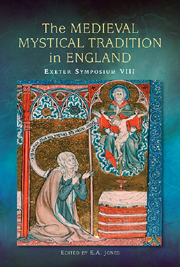 The Medieval Mystical Tradition in England
The Medieval Mystical Tradition in England Published online by Cambridge University Press: 05 July 2013
For years we have wondered if Margery Kempe could read – or at least what access to literacy she had. Why have we not wondered the following: How did Kempe count and perform mathematical operations? What did she count, and why? What kind of numeracies did Kempe possess or have access to? How did numbers and mathematical operations shape her experiences?
Numeracy, or what Americans refer to as ‘quantitative literacy’, can be defined as one's ability to understand and apply mathematical operations to everyday tasks, as well as the familiarity with mathematical concepts. Numeracy includes such wide-ranging concepts and applications as the measurement of time, money, space, shape, probability, patterns, quantity, predictions and orders of magnitude. Like literacy, numeracy is a social practice, governed and shaped in great part by gender, social status, occupation, and so on, and can be practised in a number of different settings, including the civil, the professional and the leisurely.
Basic numeracy played an important part in late-medieval spiritual practices. Thomas Lentes has argued that number lay at the root of the ‘arithmetic of salvation’: ‘Religious life was not merely marked by quantification and multiplication; rather, counting appeared as an essential component of the practice of piety’. This obsession with enumeration is often equated with the rise of mercantilism, and a number of Kempe scholars have understood the Book in this context.
To save this book to your Kindle, first ensure no-reply@cambridge.org is added to your Approved Personal Document E-mail List under your Personal Document Settings on the Manage Your Content and Devices page of your Amazon account. Then enter the ‘name’ part of your Kindle email address below. Find out more about saving to your Kindle.
Note you can select to save to either the @free.kindle.com or @kindle.com variations. ‘@free.kindle.com’ emails are free but can only be saved to your device when it is connected to wi-fi. ‘@kindle.com’ emails can be delivered even when you are not connected to wi-fi, but note that service fees apply.
Find out more about the Kindle Personal Document Service.
To save content items to your account, please confirm that you agree to abide by our usage policies. If this is the first time you use this feature, you will be asked to authorise Cambridge Core to connect with your account. Find out more about saving content to Dropbox.
To save content items to your account, please confirm that you agree to abide by our usage policies. If this is the first time you use this feature, you will be asked to authorise Cambridge Core to connect with your account. Find out more about saving content to Google Drive.